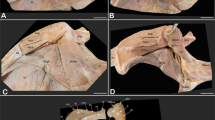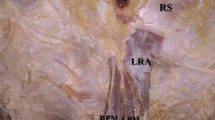Abstract
Veterinary anatomical texts have generally described the longissimus muscle only in terms of its attachment in the ox as the basic species and have not thoroughly addressed its morphology in small ruminants. Hence, the present study was designed to present the anatomical features of longissimus capitis, longissimus atlantis, longissimus cervicis, and the cranial part of longissimus thoracis of domestic goats by comparing them with the existing descriptions of these muscles in the ox. Bilateral dissections of the neck and the cranial thoracic regions of 10 domestic adult goats of both sexes were carried out. The longissimus capitis and longissimus atlantis consisted of about 5 muscle slips originating from the articular processes of C3–C7 (including their bony ridges) or T1 and the transverse process of T2. In 7 (37%) of the 19 muscles dissected, the last slips in the longissimus capitis and longissimus atlantis or in one of them showed no attachment to the vertebrae. Rather, the thoracolumbar fascia in the cranial part of the thoracic region, the cranial edge or the deep face of longissimus thoracis, and the deep face of longissimus cervicis served as the origins of the muscles. The attachment sites of the longissimus cervicis and the cranial part of the longissimus thoracis in the goat demonstrated no remarkable differences with those of the ox. Whether the attachment sites of these variants should be considered as normal or anomalous needs to be evaluated with a larger number of animals of different breeds.









Similar content being viewed by others
References
Alic I, Trbojevic Vukicevic T, Duras M, Kuzir S, Fazarinc G, Gjurcevic Kantura V (2014) Variations in pectoral girdle muscles in dogs. Anat Histol Embryol 43:16–21
Ashdown RR, Done SH & Barnett SW (2010) Color Atlas of Veterinary Anatomy, Volume 1, The Ruminants E-Book. Elsevier Health Sciences
Beena V (2019) Applications of livestock in biomedical research. J Dairy Vet Anim Res 8:107–109
Bogduk N (1980) A reappraisal of the anatomy of the human lumbar erector spinae. J Anat 131:525
Cachon T, Hassoun R, Odet M et al (2020) Morphometric dimensions of the goat thoracolumbar vertebrae using digitized CT images. Comput Methods Biomech Biomed Eng 22:S123–S125
Creze M, Soubeyrand M, Gagey O (2019) The paraspinal muscle-tendon system: Its paradoxical anatomy. PLoS ONE 14:e0214812
De Foa JL, Forrest W, Biedermann H (1989) Muscle fibre direction of longissimus, iliocostalis and multifidus: landmark-derived reference lines. J Anat 163:243
Du M, Tong J, Zhao J et al (2010) Fetal programming of skeletal muscle development in ruminant animals. J Anim Sci 88:E51-60
Dyce KM, Sack WO, Wensing CJG (2009) Textbook of veterinary anatomy-E-Book. Elsevier Health Sciences
Evans HE (1959) Hyoid muscle anomalies in the dog (Canis familiaris). Anat Rec 133:145–162
Gellman KS, Bertram JE, Hermanson JW (2002) Morphology, histochemistry, and function of epaxial cervical musculature in the horse (Equus caballus). J Morphol 251:182–194
Getty R, Sisson S (1975) Sisson and Grossman's the Anatomy of the Domestic Animals
Budras K-D & Habel RE (2011) Bovine anatomy. Schlütersche
König HE, Hans-Georg H-G, Bragulla H (2007) Veterinary anatomy of domestic mammals: textbook and colour atlas. Schattauer Verlag
Nickel R, Schummer A, Seiferle E et al (1986) The anatomy of the domestic animals, vol 1. Verlag Paul Parey, The locomotor system of the domestic mammals
Popesko P (1977) Atlas of topographical anatomy of the domestic animals
Ritruechai P, Weller R, Wakeling JM (2008) Regionalisation of the muscle fascicle architecture in the equine longissimus dorsi muscle. Equine Vet J 40:246–251
Takahashi H, Umeda M, Sakakibara A et al (2014) Absence of the sternocleidomastoid muscle in a patient that underwent neck dissection for squamous cell carcinoma of the tongue. Kobe J Med Sci 59:E167–E171
Terrado J, Ortega J (2002) Unilateral agenesis of the thyrohyoid muscle in a dog. Vet J 164:156–158
Terrado J, Giner M, Gomez O (2005) Anomalous insertion of the splenius muscle in a dog. Vet J 170:375–376
Vajramani A, Witham FM, Richards RH (2010) Congenital unilateral absence of sternocleidomastoid and trapezius muscles: a case report and literature review. J Pediatr Orthop B 19:462–464
Webster EL, Hudson PE, Channon SB (2014) Comparative functional anatomy of the epaxial musculature of dogs (C anis familiaris) bred for sprinting vs. fighting. J Anat 225:317–327
Zhao L, Huang Y, Du M (2019) Farm animals for studying muscle development and metabolism: dual purposes for animal production and human health. Anim Front 9:21–27
Acknowledgements
The author wishes to thank Mr. Habibollah Haghgooyan and Mr. Masuod Razi for technical assistance. This research was financially supported by the grants of Shiraz University Research Council.
Funding
This study was funded by School of Veterinary Medicine, Shiraz University.
Author information
Authors and Affiliations
Corresponding author
Ethics declarations
Conflict of interest
The authors declare that they have no conflict of interest.
Additional information
Publisher's Note
Springer Nature remains neutral with regard to jurisdictional claims in published maps and institutional affiliations.
Rights and permissions
About this article
Cite this article
Kamali, Y. Revision of the morphology of longissimus capitis, longissimus atlantis, longissimus cervicis, and the cranial part of longissimus thoracis in the domestic goat (Capra hircus): a cadaveric study. Anat Sci Int 97, 48–58 (2022). https://doi.org/10.1007/s12565-021-00625-8
Received:
Accepted:
Published:
Issue Date:
DOI: https://doi.org/10.1007/s12565-021-00625-8




